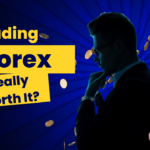Making money has been important since the dawn of time. Every life depends on it. Hence, finance has made this possible. With the introduction of forex trading, the democratisation of money has started. Now anyone can be a part of this journey.
However, the scarcity of properly tested theories and forex strategies is lacking. With the aim to satisfy the money-making habit and provide forex education, this blog targets the question of how can I make money through forex trading.
Basics of Forex Trading
Foreign exchange trading or FX trading is the flow of buying and selling international currencies. The aim here is to trade one currency for another. It is also considered as an art or science. Because the philosophy sets the game here. The currency bought must appreciate in the future to deliver promising returns. Participants in the forex market are individuals, corporations or funds, banks, and the government.
Majorly trading currencies but not limited to are USD (U.S. Dollar), JPY (Japanese Yen), EURO (The Euro) INR (Indian Rupee), GBP (The British Pound), CHF (Swiss Franc), and AUD (Australian Dollar). Almost every currency in the world trades, leaving a few exceptions. Foreign exchange trading is a success when the price quotes for one currency against the other. Hence, there are so many pairs. Some famous forex currency pairs are USD/JPY, EUR/USD, GBP/USD, and USD/CHF.
Step-by-step guide to Forex Trading
Before foreign exchange trading starts, there are a few requisites that form the basis:
Managing Expectations:
Initiating your journey into the forex market could become an arduous task. Not having the desired expectations applicable to foreign exchange trading, could lead to disastrous outcomes. So, managing expectations is the first step to trading forex.
Capital Allocation:
Having strategic capital allocation could be beneficial. Capital is the oxygen of foreign exchange trading. It could prove vital when the money flow is less in the forex market. When capital is properly allocated, the chance to earn returns is proportionally higher.
Reliable Broker:
Finding a reliable broker is crucial in the forex markets. However, the influx of a variety of brokers has made the lines of reliability a little blur. It’s like finding a needle in a haystack. Certain traits can help traders jot down some critical traits of a reliable forex broker. These traits include deposit and withdrawal requirements, trading education, customer support, and risk management.
It is important to find out the best forex broker which has your interests in mind. This is what MarketTargets stands for. And it’s pretty easy to set up your forex trading account with MarketTargets. All it needs is 3 simple steps:
- Registering the account with MarketTargets.
- Fill the account with funds.
- Start your first trade.
With over 20+ years of experience, the availability of powerful platforms, global accessibility, and exceptional support, you are bound to become a successful trader. However, an average forex trader cannot become a successful one without essential tools and forex strategies.
Essential Tools and Strategies in Forex Trading
What separates a novice trader from a professional one? It is the usage of essential tools and strategies. Especially, in the forex market, this term is well-defined. It is technical analysis. Technical analysis is the process of making meaning out of charts and indicators. Technical analysts believe that history repeats itself. It includes certain support and resistance, candlestick patterns, and indicators.
Support and Resistance:
These are points on the chart that reflect stop loss and target. Support relates to the stop loss and resistance indicates target. Stop loss is an area on charts that indicate where the stop loss order needs to be applied. Meanwhile, resistance is the area that indicates where profit booking needs to take place. As stated above, technical analysts believe that as “history repeats itself”, the support and resistance are
Candlestick Patterns:
These are the building blocks of technical analysis. Candlestick patterns can be formed with individual candlesticks and with a set of candlesticks. Some well-known candlestick patterns include:
- Marubozu:
It’s a single candlestick meaning “Bald” in Japanese. It is a single candlestick pattern.
- Bullish and Bearish Marubozu:
Bullish in the forex market means assertive or positive and bearish means having a negative view. Here, Marubozu is much more indicative of the trend.
- Spinning Top:
It is a single candlestick which indicates there is indecision in the market.
- Engulfing Pattern:
Being the first candlestick pattern, it has typically 2 candlesticks indicating bearish and bullish sentiment.
- Morning Star:
The morning star is a bullish candlestick pattern that requires at least 3 candlesticks.
Indicators:
Indicators reveal a hidden story. They identify a prior and present trend that is brewing. Indicators provide us with some critical information like the supply and demand zones, the strength of a trend, and possible support, and resistance areas.
Some widely used forex indicators are:
- Relative Strength Index (RSI):
Oscillating between 0 and 100, RSI helps in identifying trend reversals. It also comes in handy in finding demand and supply zones. Mainly, it defines the strength of a strength, hence the Relative Strength Index.
- Moving Average (MA):
An indicator that depends on foreign currency price divided by the number of days (Price/Number of days).
- Fibonacci Retracement:
Fibonacci retracement is formed by fibonacci series. It’s a sequence starting from 0 arranged in a way where the former 2 numbers are added. It helps in identifying the support and resistance levels.
Fundamental Analysis:
Fundamental analysis is the process of studying the underlying basis of any market. Without this, foreign currencies will have zero to no value. The forex market has several areas which are fundamental to its function.
- Economic Indicators:
Reflect the health of an economy. It involves factors like the GDP, consumption, international trade, and investment.
- Central Bank Policies:
This plays a major role in affecting the price of currencies. Policies like the interest rate, repo rate, and reverse repo rate play a pivotal role.
Strategies:
Before approaching any specific trade setup, strategies are tested. Strategies form a definite action plan and pathway that is well-defined. Following strategies guarantees success if playing for the long run. Famous currency trading strategies are:
- Scalping:
This strategy ensures that the trader takes small profits. Scalping is mostly done when the price gaps are small.
- Day Trading:
It refers to the buying and selling of foreign currency within the same day. Day trading ensures the squaring-off of open positions.
- Swing Trading:
In contrast to day trading, the swing trading strategy takes place when buying and selling happens in more than 1 day.
Road to Success with Forex Trading
After getting all the required forex education, it is necessary to know the essential tips that can probably give you the boost to trade. These tips will help you to trade successfully as a forex trader.
Relentless Learning:
Learning is a must to do activity while currency trading. It can be learning from our own and others’ mistakes. Learning at different levels gives you an understanding of the intricate knowledge one can possess. Forex traders should never stop learning.
Greed is your Enemy:
Greed is your enemy is the perfect statement. While losing a trade can push the traders to take unnecessary forex risks which may dampen profits. The hard-earned money could be lost in a blink of an eye.
Avoiding These Mistake Will Make You Rich
There are pitfalls to avoid in any scenario, especially in forex trading. Mistakes are a platform to learn better. This gives us an angle of learning which is quite unusual. Certain mistakes that traders must avoid in the forex market are:
Risk Management:
Avoiding unnecessary forex risks and taking necessary forex risks is paramount to wealth creation. For that, a system of risk management needs is essential. Following the system is also necessary. This is where greed and fear come into play. Greed will likely push you over the edge. And fear will stop you from taking necessary actions.
Overleveraging:
Leveraging is a crucial part of the financial system. It can make or break a trade. Taking smart leverage will improve your earnings capacity. Meanwhile, overleveraging can kill a trade. It can dampen a trader’s confidence. Deepening the losses can hurt the overall excitement of trading. Hence, a trader is lost.
Conclusion
The finale causes us to wonder, how big the world of foreign exchange trading is. However, the burning question remains, how can I make money through forex trading? By following a proper path, understanding how the forex market works, the strategies, tools, and different levels of forex analysis make the forex market. By setting up a tried and tested forex strategy, one can definitely follow the road to success. Not taking unnecessary risks and following risk management strategies are crucial to money-making.
Frequently Ask Questions (FAQ’s)
Q) Can I make money through forex trading?
Ans) Yes, it is possible to make money through foreign exchange trading. By following simple forex strategies, understanding how the market works, and keeping in check the expected return.
Q) What is day trading?
Ans) Day trading is the buying and selling of foreign exchange currency on a daily basis. Open positions are squared off at the end of the day.
Q) Is there a requirement for a broker in trading forex?
Ans) Foreign exchange trading requires a forex broker. A forex broker provides a platform for trading, where different assets such as stocks, commodities, and forex trade.
Q) What is the best technical analysis indicator?
Ans) Several indicators could be considered the best. However, Fibonacci Retracement is considered the best technical indicator.
Q) Who are the participants in the forex market?
Ans) The Forex market contains individuals, governments, big institutions or corporations, and banks.






